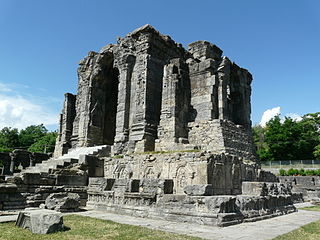Related Research Articles
This article contains information about the literary events and publications of 1642.

The history of Kashmir is intertwined with the history of the broader Indian subcontinent in South Asia with influences from the surrounding regions of Central, and East Asia. Historically, Kashmir referred to only the Kashmir Valley of the western Himalayas. Today, it denotes a larger area that includes the Indian-administered union territories of Jammu and Kashmir, Ladakh, the Pakistan-administered territories of Azad Kashmir and Gilgit-Baltistan, and the Chinese-administered regions of Aksai Chin and the Trans-Karakoram Tract.
Shingara, better known as Sultan Sikandar Shah Miri, also by his sobriquet Sikandar Butshikan was the seventh Sultan of Kashmir and a member of Shah Mir dynasty who ruled from 1389 until his death in 1413.

Kashmiri cuisine is the cuisine of the Kashmir Valley. The cuisine has strong influences from neighbouring regions in central Asia and the Indian subcontinent. Rice has been a staple food in Kashmir since ancient times. The equivalent for the phrase "bread and butter" in Kashmiri is haakh-batte.

The Shah Mir dynasty or the House of Shah Mir, was a Kashmiri dynasty that ruled the Kashmir Sultanate in the Indian subcontinent. The dynasty is named after its founder, Shah Mir.

This is a bibliography of notable works about the historical Indian subcontinent as well as the modern-day Republic of India.
Islam is the majority religion practised in Kashmir, with 97.16% of the region's population identifying as Muslims as of 2014. The religion came to the region with the arrival of Mir sayed Ali shah Hamdani, a Muslim Sufi preacher from Central Asia and Persia, beginning in the early 14th century. The majority of Kashmiri Muslims are Sunni Muslims.

Martand Sun Temple is a Hindu temple located near the city of Anantnag in the Kashmir Valley of Jammu and Kashmir, India. It dates back to the eighth century CE and was dedicated to Surya, the chief solar deity in Hinduism; Surya is also known by the Sanskrit-language synonym Martand. The temple was destroyed by Sikandar Shah Miri.
Rinchan Shah, born as Lhachen Rinchan Bhoti and also known by his titular name Sadr'ud-Din Shah, was the founder and the first Sultan of the Sultanate of Kashmir from 1320 to 1323. Originally said to have been a Ladakhi Buddhist, he converted to Islam, becoming the first Muslim ruler of Kashmir.
Mullah Nadri or Mulla Nasiri was a Persian-language poet in Kashmir during the reign of Sultan Sikandar and then at the court of Zain-ul-Abidin (1423–1473).
The Tarikh-i-Kashmir refers to several history books of Kashmir's Sultanate period, some of them lost and partially used as sources for the others.
Yousuf, born Yoūsuf (Yūsuf) Shāh Chak, was the fourth Chak Sultan of Kashmir, who ruled the Chak dynasty from 1578 to 1586. Yousuf succeeded his father, Ali Shah Chak, who crowned Yousuf before he died. Yousuf defeated all other contenders for the throne, including his uncle Abdal Chak, and ascended the throne in 1578.

The Kashmir Sultanate, historically Latinised as the Sultanate of Cashmere and officially known as the State of Kashmir, was a medieval kingdom established in the early 14th century, primarily in the Kashmir Valley, found in the northern part of the Indian subcontinent. The Sultanate was founded by Rinchan Shah, a Ladakhi noble who converted from Buddhism to Islam. The Sultanate was briefly interrupted by the Loharas until Shah Mir, a councillor of Rinchan, overthrew the Loharas and started his own dynasty. The Shah Mirs ruled from 1339 until they were deposed by the Chak warlords and nobles in 1561. The Chaks continued to rule the Sultanate until the Mughal conquest in 1586 and their surrender in 1589.
Baharistan-i-shahi means Spring Garden of Royalty is a chronicle of medieval Kashmir. The Persian manuscript was written by an anonymous author, presumably in 1614.
K. N. Pandita, also known as Kashi Nath Pandita, is an Indian Kashmiri scholar in Persian and Central Asian Studies.
Ali Shah born Alī Shāh Chak was the third Chak Sultan succeeding his brother Husain Shah Chak who abdicated the throne in 1570. He was crowned as the 21st Sultan of Kashmir and ruled the Sultanate till 1578. Ali Shah appointed his long time faithful friend Sayyid Mubarak as his Wazīr. He died in December 1578 and was buried in Srinagar, Kashmir.

The Chak or Chaq dynasty was a Kashmiri dynasty of Dardic origin that ruled over the Kashmir sultanate in medieval Kashmir after the Shah Mir dynasty. The dynasty rose to power in 1561 in Srinagar after the death of the Turco-Mongol military general, Mirza Haidar Dughlat when Ghazi Shah assumed the throne by dethroning Habib Shah, the last Shah Mir Sultan. The dynasty ended in 1589 when Yakub Shah surrendered to Mughal Emperor Akbar.
Husain, born Ḥusaīn Shāh Chak was the second Chak Sultan. He succeeded his brother Ghazi Shah Chak after Ghazi abdicated the throne in Husain's favour in 1563. Husain was the 20th Sultan of Kashmir and ruled Kashmir until 1570.
Ghazi, born Ghāzī Shāh Chak was the first Chak Sultan. He dethroned the last Shah Mir Sultan, Habib Shah, in 1561 and succeeded him under the title of Muhammad Humayun. He was the 19th Sultan of Kashmir and ruled Kashmir till he was forced to abdicate in 1563.
The Shah Mir–Lohara War, which took place in 1338–1339, was a military conflict in the Kashmir Valley between the royal forces of the ruling Hindu Lohara dynasty, led by Kota Rani, against the rebellious Muslim Shah Mir dynasty, led by former courtier Shah Mir. It resulted in the overthrowing of the Loharas and the revival of the Kashmir Sultanate.